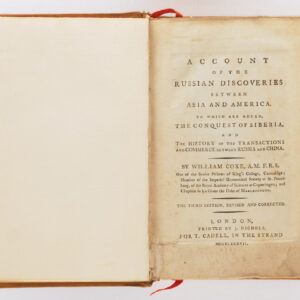Educating school children during the Cold War: Soviet historical wall map of the Russian Empire in the 18th century.
[Title in Russian] Russian Empire in the 18th Century (European Section)
$675
1 in stock
Description
РОССИЙСКАЯ ИМПЕИЯ в ХVIII в (ЕВРОПЕЙСКАЯ ЧАСТЬ)
Published during the rule of Leonid Brezhnev, this large map would have hung in a Soviet school classroom. Its subject is historical, illustrating key events of the Russian Empire in Europe during the 18th century. The map gives particular emphasis to events during the reigns of Peter the Great (r. 1682 – 1725) and Catherine the Great (r. 1762 – 1796).
With dramatic arrows, explosions, and illustrated soldiers, the map shows how Peter first directed military efforts against the Ottoman Turks, and then turned his attention to northwards. Peter still lacked a secure northern seaport, except at Archangel on the White Sea, where the harbor was frozen for nine months a year. Access to the Baltic Sea was blocked by Sweden, whose territory enclosed it on three sides. Peter’s ambitions for a “window to the sea” led him to make a secret alliance in 1699 with Saxony, the Polish–Lithuanian Commonwealth, and Denmark against Sweden. They conducted the Great Northern War, which ended in 1721 when an exhausted Sweden asked for peace with Russia.
For her part, Catherine the Great extended Russian political control over the lands of the Polish–Lithuanian Commonwealth. Catherine successfully waged war against the Ottoman Empire and advanced Russia’s southern boundary to the Black Sea. The Siege of Izmail, a key event from this period, is wonderfully illustrated on the map by a fort, battling ships, and Ottoman and Russian soldiers facing each other. In March 1790, the Russians began besieging Izmail, in the region of Budjak (now in Ukraine), which had a garrison of 40,000 soldiers. Russian forces bombarded Izmail until 3:00 A.M., and then stormed it at 5:30 A.M. By 8:00 A.M. they had entered the city. In total, the Ottoman forces had more than 26,000 killed with the whole garrison being killed, wounded, or captured. The Russian forces suffered only 4,330 casualties, out of which 1,815 were killed.
To the victory was dedicated the anthem “Grom pobedy, razdavaysya!” (Let the thunder of victory sound!) which was an unofficial Russian national anthem in the late 18th and early 19th centuries. Today it is commemorated as a Day of Military Honour in Russia.
The siege is dramatized in cantos 7 and 8 of Lord Byron’s verse-novel Don Juan (1823). His principal source, he states in the preface, was Gabriel de Castelnau’s account of the siege in Essai sur l’histoire ancienne et moderne de la Nouvelle Russie (1820).
Cartographer(s):
Condition Description
On canvas. Wear from use.
References


![[PRAGUE] Wahrhaffte Contrafactur der Weit Berühmbten Königlichen Haupt Statt Prag in Böhmen, Wie Solche Jetziger Zeit im Wesen Steht / Praga.](https://neatlinemaps.com/wp-content/uploads/2023/03/NL-01567_thumbnail-300x300.jpg)
![Flag Map of California [Signed in pencil by W.J. Goodacre]](https://neatlinemaps.com/wp-content/uploads/2022/01/NL-01134_thumbnail-scaled-300x300.jpg)
![Flag Map of California [Signed in pencil by W.J. Goodacre]](https://neatlinemaps.com/wp-content/uploads/2022/01/NL-01134_thumbnail-scaled.jpg)